|
Old Station Tintern
Tintern railway station served the village of Tintern on the Wye Valley Railway. It was opened in 1876 and closed for passengers in 1959 and freight in 1964, when the line was closed completely. It was the second largest station on the line, the most substantial being Monmouth Troy railway station.B. M. Handley and R. Dingwall, ''The Wye Valley Railway and the Coleford Branch'', 1982, History The station was opened on 1 November 1876 and was one of the four original stations along the line. It consisted of a signal box, sidings, goods shed, station building, three platforms (two of which were island platforms), and a section of double track to allow trains to pass each other. It was a large station because the railway company hoped to generate much income from tourist traffic visiting the famous Tintern Abbey. The station was host to a GWR camp coach from 1935 to 1939. A camping coach was also positioned here by the Western Region from 1956 to 1962. Today The Old Station ... [...More Info...] [...Related Items...] OR: [Wikipedia] [Google] [Baidu] |
Tintern
Tintern () is a village in the community (Wales), community of Wye Valley (community), Wye Valley, on the west bank of the River Wye in Monmouthshire, Wales, close to the border with England, about north of Chepstow. It is popular with tourists, in particular for the scenery and the ruined Tintern Abbey. Modern Tintern has been formed by the coalescence of two historic villages: Tintern Parva, forming the northern end of the village, and Chapel Hill, which forms the southern end. The village is designated as a Conservation Area (United Kingdom), Conservation Area. In 2022 the community was renamed from "Tintern" to "Wye Valley" and had boundary changes. History Early history The name Tintern may derive from the Welsh ''din'' + ''d/teyrn'', meaning "rocks of the king".E. T. Davies, ''A History of the Parish of Mathern'', 1990 A Ford (crossing), ford, known as Tintern Ford, stretched across the tidal River Wye and was in use in Roman times. After the Romans withdrew from Wales ... [...More Info...] [...Related Items...] OR: [Wikipedia] [Google] [Baidu] |
Netherhope Halt Railway Station
Netherhope Halt was a railway station on the former Wye Valley Railway The Wye Valley Railway was a standard gauge railway that ran for nearly along the Lower Wye Valley between the towns of Chepstow and Monmouth, crossing several times between Wales and England. Opened on 1 November 1876, it was leased to, and w .... It was opened in 1932 and closed in 1959; it was demolished soon afterwards.B. M. Handley and R. Dingwall, ''The Wye Valley Railway and the Coleford Branch'', 1982, References * Former Great Western Railway stations Disused railway stations in Gloucestershire Railway stations in Great Britain opened in 1932 Railway stations in Great Britain closed in 1959 Tidenham {{Gloucestershire-struct-stub ... [...More Info...] [...Related Items...] OR: [Wikipedia] [Google] [Baidu] |
Tourist Attractions In Monmouthshire
Tourism is travel for pleasure, and the Commerce, commercial activity of providing and supporting such travel. World Tourism Organization, UN Tourism defines tourism more generally, in terms which go "beyond the common perception of tourism as being limited to holiday activity only", as people "travelling to and staying in places outside their usual environment for not more than one consecutive year for leisure and not less than 24 hours, business and other purposes". Tourism can be Domestic tourism, domestic (within the traveller's own country) or International tourism, international. International tourism has both incoming and outgoing implications on a country's balance of payments. Between the second half of 2008 and the end of 2009, tourism numbers declined due to a severe Economy, economic slowdown (see Great Recession) and the outbreak of the 2009 2009 flu pandemic, H1N1 influenza virus. These numbers, however, recovered until the COVID-19 pandemic put an abrupt end to th ... [...More Info...] [...Related Items...] OR: [Wikipedia] [Google] [Baidu] |
Railway Stations In Great Britain Closed In 1959
Rail transport (also known as train transport) is a means of transport using wheeled vehicles running in tracks, which usually consist of two parallel steel rails. Rail transport is one of the two primary means of land transport, next to road transport. It is used for about 8% of passenger and freight transport globally, thanks to its energy efficiency and potentially high speed. Rolling stock on rails generally encounters lower frictional resistance than rubber-tyred road vehicles, allowing rail cars to be coupled into longer trains. Power is usually provided by diesel or electric locomotives. While railway transport is capital-intensive and less flexible than road transport, it can carry heavy loads of passengers and cargo with greater energy efficiency and safety. Precursors of railways driven by human or animal power have existed since antiquity, but modern rail transport began with the invention of the steam locomotive in the United Kingdom at the beginning of the ... [...More Info...] [...Related Items...] OR: [Wikipedia] [Google] [Baidu] |
Railway Stations In Great Britain Opened In 1876
Rail transport (also known as train transport) is a means of transport using wheeled vehicles running in tracks, which usually consist of two parallel steel rails. Rail transport is one of the two primary means of land transport, next to road transport. It is used for about 8% of passenger and freight transport globally, thanks to its energy efficiency and potentially high speed.Rolling stock on rails generally encounters lower frictional resistance than rubber-tyred road vehicles, allowing rail cars to be coupled into longer trains. Power is usually provided by diesel or electric locomotives. While railway transport is capital-intensive and less flexible than road transport, it can carry heavy loads of passengers and cargo with greater energy efficiency and safety. Precursors of railways driven by human or animal power have existed since antiquity, but modern rail transport began with the invention of the steam locomotive in the United Kingdom at the beginning of the 19th c ... [...More Info...] [...Related Items...] OR: [Wikipedia] [Google] [Baidu] |
British Railways
British Railways (BR), which from 1965 traded as British Rail, was a state-owned company that operated most rail transport in Great Britain from 1948 to 1997. Originally a trading brand of the Railway Executive of the British Transport Commission, it became an independent statutory corporation in January 1963, when it was formally renamed the British Railways Board. British Railways was formed on 1 January 1948 as a result of the Transport Act 1947, which nationalisation, nationalised the Big Four (British railway companies), Big Four British railway companies along with some other (but not all) smaller railways. Profitability of the railways became a pressing concern during the 1950s, leading to multiple efforts to bolster performance, including some line closures. The History of rail transport in Great Britain 1948–1994#The Modernisation Plan, 1955 Modernisation Plan formally directed a process of dieselisation and Railway electrification in Great Britain, electrification ... [...More Info...] [...Related Items...] OR: [Wikipedia] [Google] [Baidu] |
Brockweir Halt Railway Station
Brockweir Halt was a request stop on the former Wye Valley Railway. It was opened to the public on 19 August 1929. It closed in 1959 when passenger services were withdrawn from the line. It was situated just north of Brockweir Brockweir is a village in Hewelsfield and Brockweir civil parish, in the Forest of Dean District of Gloucestershire, England. The civil parish also includes the separate village of Hewelsfield. The village is located on the eastern bank of ... bridge. Nothing now remains of the trackbed because of the realignment of the A466.B. M. Handley and R. Dingwall, ''The Wye Valley Railway and the Coleford Branch'', 1982, References * Disused railway stations in Monmouthshire Former Great Western Railway stations Railway stations in Great Britain opened in 1929 Railway stations in Great Britain closed in 1959 Wye Valley Railway {{Wales-railstation-stub ... [...More Info...] [...Related Items...] OR: [Wikipedia] [Google] [Baidu] |
Wye Valley
The Wye Valley () is a valley in Wales and England. The River Wye () is the Rivers of Great Britain#Longest rivers in the United Kingdom, fourth-longest river in the United Kingdom. The upper part of the valley is in the Cambrian Mountains and is enclosed by hills as it descends through Rhayader, Builth Wells and Hay-on-Wye before reaching the England-Wales border and becoming a broader vale through Hereford. The lower part of the valley meanders past Ross-on-Wye and Monmouth, where it becomes the England-Wales border, before reaching the Severn Estuary at Chepstow. Much of this section features limestone gorge scenery and dense native woodlands, which made the Wye Valley historically important as one of the birthplaces of the modern tourism industry. The lower part of the valley is designated as the Wye Valley National Landscape, an Area of Outstanding Natural Beauty, protected as an internationally important landscape. This designation covers covers surrounding a stretch o ... [...More Info...] [...Related Items...] OR: [Wikipedia] [Google] [Baidu] |
Monmouthshire
Monmouthshire ( ; ) is a Principal areas of Wales, county in the South East Wales, south east of Wales. It borders Powys to the north; the English counties of Herefordshire and Gloucestershire to the north and east; the Severn Estuary to the south, and Torfaen, Newport, Wales, Newport and Blaenau Gwent to the west. The largest town is Abergavenny, and the administrative centre is Usk. The county is administered by Monmouthshire County Council. It sends two directly-elected members to the Senedd at Cardiff and one elected member to the Parliament of the United Kingdom, UK parliament at Westminster. The county name is identical to that of the Monmouthshire (historic), historic county, of which the current local authority covers the eastern three-fifths. Between 1974 and 1996, the county was known as Gwent (county), Gwent, recalling Kingdom of Gwent, the medieval kingdom which covered a similar area. The present county was formed under the Local Government (Wales) Act 1994, which ... [...More Info...] [...Related Items...] OR: [Wikipedia] [Google] [Baidu] |
Western Region Of British Railways
The Western Region was a region of British Railways from 1948. The region ceased to be an operating unit in its own right on completion of the "Organising for Quality" initiative on 6 April 1992. The Region consisted principally of ex-Great Western Railway lines, minus certain lines west of Birmingham, which were transferred to the London Midland Region in 1963 and with the addition of all former Southern Railway routes west of Exeter, which were subsequently rationalised. History When British Railways was created at the start of 1948, it was immediately subdivided into six Regions, largely based upon pre-nationalisation ownership. The Western Region initially consisted of the former Great Western Railway system, totalling 3,782 route miles and with its headquarters at Paddington. To this was added some minor railways and joint lines in which the GWR had an interest: * Brynmawr and Western Valleys Railway * Clifton Extension Railway * Easton and Church Hope Railway *Great ... [...More Info...] [...Related Items...] OR: [Wikipedia] [Google] [Baidu] |
Camping Coach
Camping coaches were holiday accommodation offered by many Rail transport, railway companies in the United Kingdom and the Republic of Ireland from the 1930s. The Coach (rail), coaches were old passenger vehicles no longer suitable for use in trains, which were converted to provide sleeping and living space at static locations. The charges for the use of these coaches were designed to encourage groups of people to travel by train to the stations where they were situated; they were also encouraged to make use of the railway to travel around the area during their holiday. History Camping coaches were first introduced by the London and North Eastern Railway in 1933, when they positioned ten coaches in picturesque places around their network. The following year, two other railway companies followed suit: the London, Midland and Scottish Railway, with what it originally called "caravans", and the Great Western Railway which called them "camp coaches". In 1935 they were introduced on ... [...More Info...] [...Related Items...] OR: [Wikipedia] [Google] [Baidu] |









